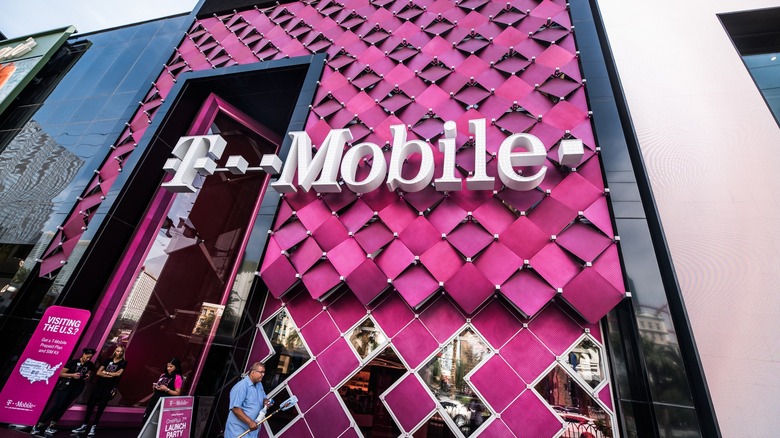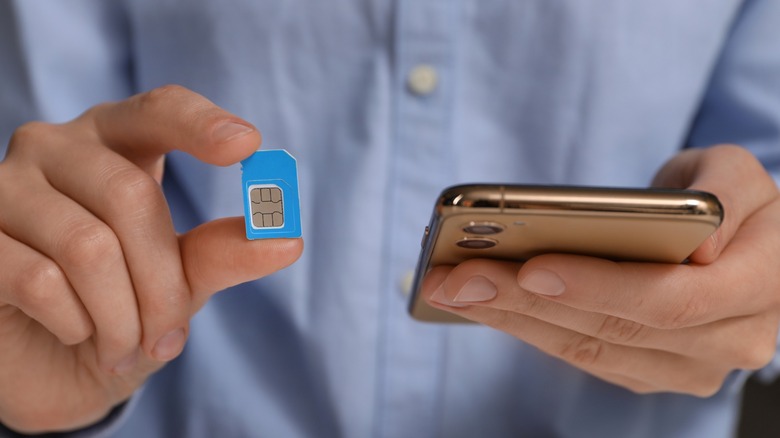T-Mobile's Coverage Map: How It Compares To Other Cellular Providers
It may sound odd, but despite being well into the 21st century, we still worry about whether our smartphones will have service in certain locations. We can communicate around the globe in an instant, but if you drive into the wrong part of town, you may lose access to your phone's most important features. That's why, when you're considering a provider switch, you need to know what coverage looks like for all of your options.
Among the top three wireless operators in the United States is T-Mobile, a service provider that, despite some coverage issues, still finds a way to remain competitive. Compared to Verizon and AT&T, the pink-branded provider may have a way to go before it reaches the same blanket of standard 4G coverage, but a bigger focus on 5G is sure to attract customers with an eye on the future of mobile devices.
A little perspective is needed for this whole discussion, though, as coverage isn't the only factor to consider when signing up for T-Mobile. While T-Mobile still ranks lowest in 4G coverage percentage nationwide, the mobile provider may have a leg up in speed. Also, despite its shortcomings in coverage, T-Mobile is definitely not the worst option available.
T-Mobile vs. Verizon and AT&T coverage
You may hear customers tout that their service works better than someone they know on another carrier. However, there's a surefire way to determine if you're at least in the market for decent coverage with a provider like T-Mobile. The FCC offers a color overlay map that shows just how much coverage each of the big three providers provides nationwide. Based on the FCC map, data from the last update in June 2023 shows that T-Mobile is trailing far behind with its 4G coverage. When put into a percentage, T-Mobile only covers about 35% of the nation with 4G LTE coverage.
However, smartphones have been pushing 5G more, and it's here where T-Mobile gains a little ground. With over 27% of the nation covered by its 7/1 Mbps 5G speeds, T-Mobile leaves Verizon's 11.25% 7/1 Mbps 5G coverage in the dust. It even comes closer to AT&T's 31.67% coverage, though T-Mobile's 35/3 Mbps 5G speed has slightly better coverage than AT&T's.
The biggest 4G coverage gaps for T-Mobile occur in the west, with states like Idaho, Oregon, and Arizona seeing large dead zones. AT&T and Verizon fill in most of those gaps, with the former servicing Arizona better than its competitors. There are pockets in Oklahoma and Kentucky that Verizon fails to cover, but T-Mobile doesn't. Overall, while T-Mobile's 4G coverage is lacking, as phones become more reliant on 5G, it will be primed to outshine or match Verizon and AT&T.
How do MVNO carriers measure up to T-Mobile
While shopping for a carrier, you may have encountered names like Mint Mobile, Google Fi, Boost Mobile, and Consumer Cellular. While you may have been intrigued by their lower-cost cellular plans, there are a few things to consider before you sign up. These companies are MVNOs or mobile virtual network operators. In fact, these four carriers are a very small drop in a rather large pool of MVNO options.
MVNOs differ from the big three carriers because they don't have their own network. To provide a signal, they use T-Mobile, Verizon, or AT&T's networks. Mint, Google Fi, Boost Mobile, and Consumer Cellular are relevant to this discussion because they all work off T-Mobile's network. So, logic would suggest that they'd provide the same coverage and speed as T-Mobile does to its direct customers, right? Not quite. Service from a provider like Mint Mobile will experience deprioritization, directly impacting your service's quality. That said, some MNVOs like Mint Mobile offer special discounts and perks as well.
The short version is that if you've subscribed to an MVNO, your service will be temporarily slowed during times of network congestion to allow for a smoother experience for T-Mobile customers. Some providers, like Google Fi, don't subject customers to a deprioritization threshold, while other providers may limit high-speed network coverage to 30GB before deprioritizing. While T-Mobile may fall behind Verizon and AT&T, it's slightly more favorable than most MVNOs because of deprioritization.
Does T-Mobile's pricing make up for its reduced coverage?
According to T-Mobile, its lowest-tier Essentials Saver plan is $65 per month for one line. That gets users 50GB of premium data, unlimited talk and text, and unlimited 5G and 4G LTE high-speed data. For $65 per month for one line and using auto-pay, Verizon offers unlimited 5G and 4G LTE data and unlimited talk and text. Similarly, AT&T's most comparable plan is $65.99, which more or less matches what Verizon and T-Mobile offer.
You do lose T-Mobile's premium data, but there's actually no difference between premium and standard data. The 50GB premium data simply means that, for 50GB, you won't be subject to throttling or forced speed reductions at times of high congestion.
As you move up each tier, T-Mobile plans actually get to be more expensive than Verizon and AT&T. One of the perks available in the second-highest tier, which costs $95 per month for one 1 line, with phone upgrades available. This plan also has "unlimited" premium data, though it's subject to data prioritization after 100GB.



